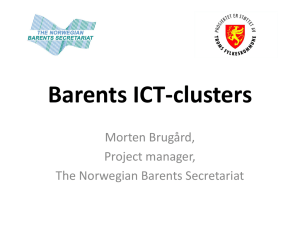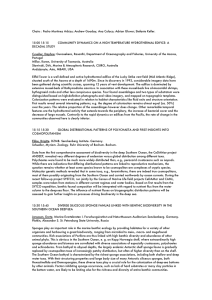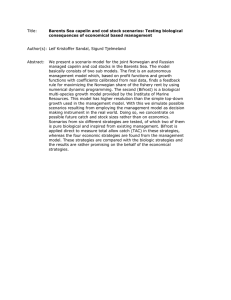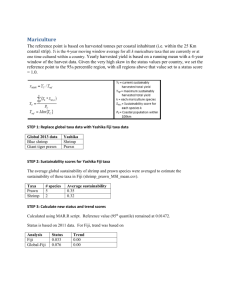MARBEF successfully. It is now established in the
advertisement
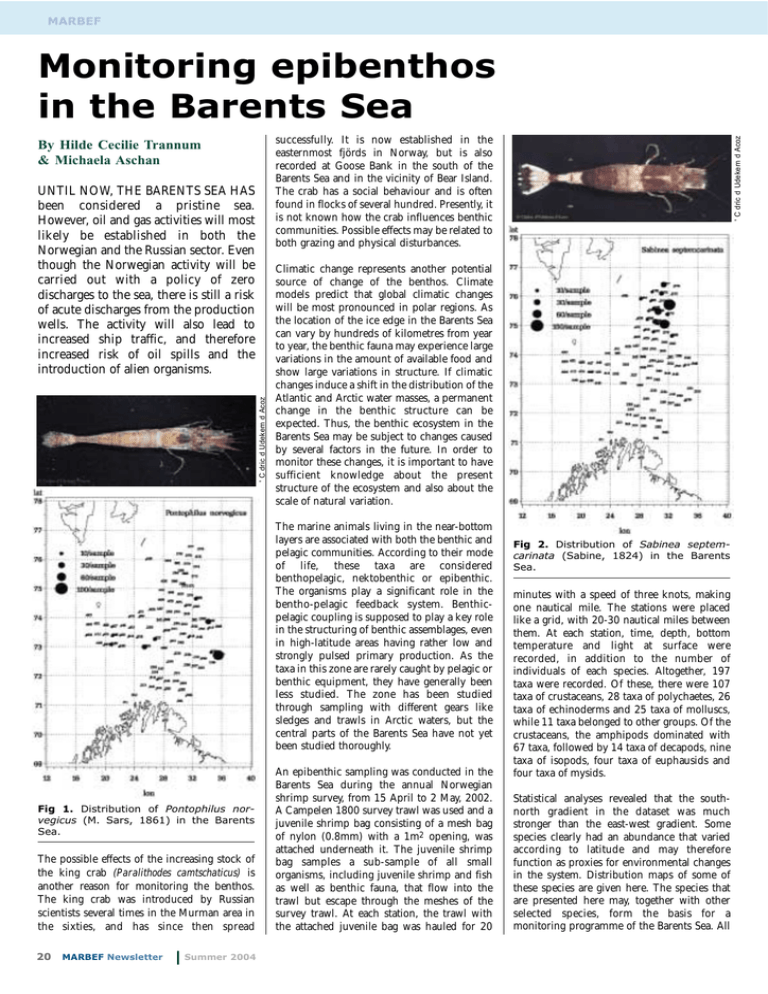
MARBEF successfully. It is now established in the easternmost fjörds in Norway, but is also recorded at Goose Bank in the south of the Barents Sea and in the vicinity of Bear Island. The crab has a social behaviour and is often found in flocks of several hundred. Presently, it is not known how the crab influences benthic communities. Possible effects may be related to both grazing and physical disturbances. By Hilde Cecilie Trannum & Michaela Aschan ' C dric d Udekem d Acoz UNTIL NOW, THE BARENTS SEA HAS been considered a pristine sea. However, oil and gas activities will most likely be established in both the Norwegian and the Russian sector. Even though the Norwegian activity will be carried out with a policy of zero discharges to the sea, there is still a risk of acute discharges from the production wells. The activity will also lead to increased ship traffic, and therefore increased risk of oil spills and the introduction of alien organisms. Climatic change represents another potential source of change of the benthos. Climate models predict that global climatic changes will be most pronounced in polar regions. As the location of the ice edge in the Barents Sea can vary by hundreds of kilometres from year to year, the benthic fauna may experience large variations in the amount of available food and show large variations in structure. If climatic changes induce a shift in the distribution of the Atlantic and Arctic water masses, a permanent change in the benthic structure can be expected. Thus, the benthic ecosystem in the Barents Sea may be subject to changes caused by several factors in the future. In order to monitor these changes, it is important to have sufficient knowledge about the present structure of the ecosystem and also about the scale of natural variation. The marine animals living in the near-bottom layers are associated with both the benthic and pelagic communities. According to their mode of life, these taxa are considered benthopelagic, nektobenthic or epibenthic. The organisms play a significant role in the bentho-pelagic feedback system. Benthicpelagic coupling is supposed to play a key role in the structuring of benthic assemblages, even in high-latitude areas having rather low and strongly pulsed primary production. As the taxa in this zone are rarely caught by pelagic or benthic equipment, they have generally been less studied. The zone has been studied through sampling with different gears like sledges and trawls in Arctic waters, but the central parts of the Barents Sea have not yet been studied thoroughly. Fig 1. Distribution of Pontophilus norvegicus (M. Sars, 1861) in the Barents Sea. The possible effects of the increasing stock of the king crab (Paralithodes camtschaticus) is another reason for monitoring the benthos. The king crab was introduced by Russian scientists several times in the Murman area in the sixties, and has since then spread 20 MARBEF Newsletter Summer 2004 ' C dric d Udekem d Acoz Monitoring epibenthos in the Barents Sea An epibenthic sampling was conducted in the Barents Sea during the annual Norwegian shrimp survey, from 15 April to 2 May, 2002. A Campelen 1800 survey trawl was used and a juvenile shrimp bag consisting of a mesh bag of nylon (0.8mm) with a 1m2 opening, was attached underneath it. The juvenile shrimp bag samples a sub-sample of all small organisms, including juvenile shrimp and fish as well as benthic fauna, that flow into the trawl but escape through the meshes of the survey trawl. At each station, the trawl with the attached juvenile bag was hauled for 20 Fig 2. Distribution of Sabinea septemcarinata (Sabine, 1824) in the Barents Sea. minutes with a speed of three knots, making one nautical mile. The stations were placed like a grid, with 20-30 nautical miles between them. At each station, time, depth, bottom temperature and light at surface were recorded, in addition to the number of individuals of each species. Altogether, 197 taxa were recorded. Of these, there were 107 taxa of crustaceans, 28 taxa of polychaetes, 26 taxa of echinoderms and 25 taxa of molluscs, while 11 taxa belonged to other groups. Of the crustaceans, the amphipods dominated with 67 taxa, followed by 14 taxa of decapods, nine taxa of isopods, four taxa of euphausids and four taxa of mysids. Statistical analyses revealed that the southnorth gradient in the dataset was much stronger than the east-west gradient. Some species clearly had an abundance that varied according to latitude and may therefore function as proxies for environmental changes in the system. Distribution maps of some of these species are given here. The species that are presented here may, together with other selected species, form the basis for a monitoring programme of the Barents Sea. All ' F. Buchholz, AWI, fbuchholz@awi-bremerhaven.de Meganyctiphanes norvegica (M. Sars, 1856) (Northern krill). the species should be easy to identify with only very slight magnification, which means that the work can be conducted on board the ship. Furthermore, the fact that the sampling is coupled with an already ongoing annual cruise reduces the costs associated with the monitoring. It is suggested that the epibenthic study be conducted annually in connection with the Norwegian shrimp survey. Thereby it will be possible to separate long-time changes from annual variation in the benthic communities. species if the annual sampling with the juvenile shrimp bag cannot be afforded. The larger invertebrates are also caught in the main trawl with the shrimp and the fish, e.g. Pontophilus norvegicus and Sabinea septemcarinata. These two invertebrates were recorded during the shrimp cruises in 2003 and 2004 and may be recorded in the future. This offers the opportunity of monitoring these If the juvenile bag is used in most of the annual shrimp surveys conducted throughout the North Atlantic, the proposed monitoring may in the long run contribute to a standardised sampling tool for cost-effective monitoring of the benthic epibenthos of the North Atlantic. • Hilde Cecilie Trannum, Akvaplan-niva AS, PO Box 173 Kjelsaas, N-0411 Oslo, Norway. \Michaela Aschan, Institute of Marine Research, PO Box 6404, N-9294 Tromsø, Norway. Additional reading Fig 3. Distribution of Meganycti-phanes norvegica (M. Sars, 1856) (Northern krill) in the Barents Sea. Fig 4. Distribution of Thysanoessa sp. in the Barents Sea. Cochrane, S.J., S. Dahle, E. Oug, B. Gulliksen, & S. Denisenko, 1998. Benthic fauna in the Northern Barents Sea. Akvaplan-niva report APN 434.97.1286. 33pp plus appendix. ISBN 82-449-0040-7. Kiyko O.A. & V.B. Pogrebov, 1997. Longterm Benthic Population Changes (19201930s to present) in the Barents and Kara Seas. Marine Pollution Bulletin, 35: 7-12, pp 322-332. Morison, J., K. Aagaard & M. Steele, 2000. Recent environmental changes in the Arctic: A review. Arctic 53:359-371. Trannum, H.C. & Aschan, M. Cost-effective monitoring of epibenthos in the Barents Sea. Manuscript. Summer 2004 MARBEF Newsletter 21


